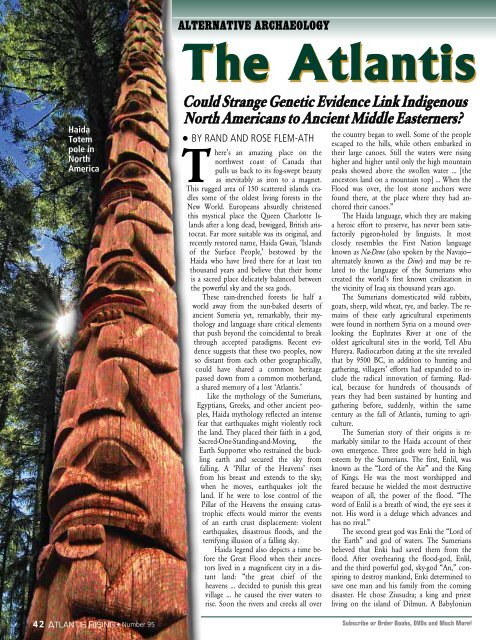Do We Know What We Think We Know About ... - TheUFOStore.com
Do We Know What We Think We Know About ... - TheUFOStore.com
Do We Know What We Think We Know About ... - TheUFOStore.com
You also want an ePaper? Increase the reach of your titles
YUMPU automatically turns print PDFs into web optimized ePapers that Google loves.
Haida<br />
Totem<br />
pole in<br />
North<br />
America<br />
42 ATLANTIS ATLANTIS RISING RISING • Number 95<br />
ALTERNATIVE ARCHAEOLOGY<br />
The Atlantis<br />
Could Could Strange Strange Genetic Genetic Evidence Evidence Link Link Indigenous Indigenous<br />
North North Americans Americans to to Ancient Ancient Middle Middle Easterners? Easterners?<br />
• BY RAND AND ROSE FLEM-ATH<br />
There’s an amazing place on the<br />
northwest coast of Canada that<br />
pulls us back to its fog-swept beauty<br />
as inevitably as iron to a magnet.<br />
This rugged area of 150 scattered islands cradles<br />
some of the oldest living forests in the<br />
New World. Europeans absurdly christened<br />
this mystical place the Queen Charlotte Islands<br />
after a long dead, bewigged, British aristocrat.<br />
Far more suitable was its original, and<br />
recently restored name, Haida Gwaii, ‘Islands<br />
of the Surface People,’ bestowed by the<br />
Haida who have lived there for at least ten<br />
thousand years and believe that their home<br />
is a sacred place delicately balanced between<br />
the powerful sky and the sea gods.<br />
These rain-drenched forests lie half a<br />
world away from the sun-baked deserts of<br />
ancient Sumeria yet, remarkably, their mythology<br />
and language share critical elements<br />
that push beyond the coincidental to break<br />
through accepted paradigms. Recent evidence<br />
suggests that these two peoples, now<br />
so distant from each other geographically,<br />
could have shared a <strong>com</strong>mon heritage<br />
passed down from a <strong>com</strong>mon motherland,<br />
a shared memory of a lost ‘Atlantis.’<br />
Like the mythology of the Sumerians,<br />
Egyptians, Greeks, and other ancient peoples,<br />
Haida mythology reflected an intense<br />
fear that earthquakes might violently rock<br />
the land. They placed their faith in a god,<br />
Sacred-One-Standing-and-Moving, the<br />
Earth Supporter who restrained the buckling<br />
earth and secured the sky from<br />
falling. A ‘Pillar of the Heavens’ rises<br />
from his breast and extends to the sky;<br />
when he moves, earthquakes jolt the<br />
land. If he were to lose control of the<br />
Pillar of the Heavens the ensuing catastrophic<br />
effects would mirror the events<br />
of an earth crust displacement: violent<br />
earthquakes, disastrous floods, and the<br />
terrifying illusion of a falling sky.<br />
Haida legend also depicts a time before<br />
the Great Flood when their ancestors<br />
lived in a magnificent city in a distant<br />
land: “the great chief of the<br />
heavens … decided to punish this great<br />
village … he caused the river waters to<br />
rise. Soon the rivers and creeks all over<br />
the country began to swell. Some of the people<br />
escaped to the hills, while others embarked in<br />
their large canoes. Still the waters were rising<br />
higher and higher until only the high mountain<br />
peaks showed above the swollen water … [the<br />
ancestors land on a mountain top] … When the<br />
Flood was over, the lost stone anchors were<br />
found there, at the place where they had anchored<br />
their canoes.”<br />
The Haida language, which they are making<br />
a heroic effort to preserve, has never been satisfactorily<br />
pigeon-holed by linguists. It most<br />
closely resembles the First Nation language<br />
known as Na-Dene (also spoken by the Navajo—<br />
alternately known as the Dine) and may be related<br />
to the language of the Sumerians who<br />
created the world’s first known civilization in<br />
the vicinity of Iraq six thousand years ago.<br />
The Sumerians domesticated wild rabbits,<br />
goats, sheep, wild wheat, rye, and barley. The remains<br />
of these early agricultural experiments<br />
were found in northern Syria on a mound overlooking<br />
the Euphrates River at one of the<br />
oldest agricultural sites in the world, Tell Abu<br />
Hureya. Radiocarbon dating at the site revealed<br />
that by 9500 BC, in addition to hunting and<br />
gathering, villagers’ efforts had expanded to include<br />
the radical innovation of farming. Radical,<br />
because for hundreds of thousands of<br />
years they had been sustained by hunting and<br />
gathering before, suddenly, within the same<br />
century as the fall of Atlantis, turning to agriculture.<br />
The Sumerian story of their origins is remarkably<br />
similar to the Haida account of their<br />
own emergence. Three gods were held in high<br />
esteem by the Sumerians. The first, Enlil, was<br />
known as the “Lord of the Air” and the King<br />
of Kings. He was the most worshipped and<br />
feared because he wielded the most destructive<br />
weapon of all, the power of the flood. “The<br />
word of Enlil is a breath of wind, the eye sees it<br />
not. His word is a deluge which advances and<br />
has no rival.”<br />
The second great god was Enki the “Lord of<br />
the Earth” and god of waters. The Sumerians<br />
believed that Enki had saved them from the<br />
flood. After overhearing the flood-god, Enlil,<br />
and the third powerful god, sky-god “An,” conspiring<br />
to destroy mankind, Enki determined to<br />
save one man and his family from the <strong>com</strong>ing<br />
disaster. He chose Ziusudra; a king and priest<br />
living on the island of Dilmun. A Babylonian<br />
Subscribe or Order Books, DVDs and Much More!


